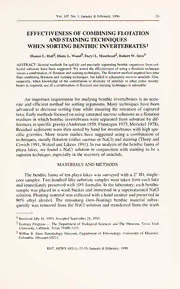
Effectiveness Of Combining Flotation And Staining Techniques When Sorting Benthic Invertebrates PDF
Preview Effectiveness Of Combining Flotation And Staining Techniques When Sorting Benthic Invertebrates
Vol. 107,No. 1,January&February, 1996 33 EFFECTIVENESS OF COMBINING FLOTATION AND STAINING TECHNIQUES WHEN SORTING BENTHIC INVERTEBRATES1 DianneL.Hall2,DianeL.Wood3,DarylL.Moorhead2,RobertW.Sites3 ABSTRACT: Several methods forquicklyandprecisely separatingbenthic organisms fromcol- lected substrate have been suggested. We tested theeffectiveness ofusing a flotation technique versusacombinationofflotationandstainingtechniques.Theflotationmethodrequiredlesstime thancombiningflotationandstainingtechniques,butfailedtoadequately recoverannelids.Con- sequently, when knowledge ofthe contribution to diversity ofannelids or other dense inverte- bratesis required, useofacombinationofflotationandstainingtechniques isadvisable. An important requirement for studying benthic invertebrates is an accu- rate and efficient method for sorting organisms. Many techniques have been advanced to decrease sorting time while ensuring the retention of captured taxa. Early methods focusedon using saturated sucrose solutions as aflotation medium in which benthic invertebrates were separated from substrate by dif- ferences in specific gravity (Anderson 1959, Flannagan 1973, Merickel 1978). Residual sediments were then sorted by hand for invertebrates with high spe- cific gravities. More recent studies have suggested using a combination of techniques, mostly flotation (either sucrose or NaCl) and staining (Thorp and Covich 1991, Wetzel and Likens 1991). In ouranalysisofthe benthic faunaof playa lakes, we found a NaCl solution in conjunction with staining to be a superior technique, especially in the recovery ofannelids. MATERIALS AND METHODS The benthic fauna of ten playa lakes was surveyed with a 2" ID, single- core sampler. Two hundred fifty substrate samples were taken from each lake and immediately preserved with 10% formalin. In the laboratory, each benthic sample was placed in a wash bucket and immersed in a supersaturated NaCl solution. Floating material wascollected with ahand strainerand preserved in 80% ethyl alcohol. The remaining (non-floating) benthic material subse- quently was removed from the NaCl solution and transferred from the wash 1 ReceivedJuly24, 1995, AcceptedSeptember28, 1995. 2Ecology Program -- The Department of Biological Sciences and The Museum, Texas Tech University,Lubbock,Texas79409-3131. 3Wilbur R. Enns Entomology Museum, Department of Entomology, University of Missouri, Columbia, Missouri65211. ENT. NEWS 107(1): 33-35,January&February, 1996 34 ENTOMOLOGICALNEWS bucket into a white enamel sorting pan. Tap water was added to the pan until the sediment was covered by a thin layer ofwater. Approximately one gm of rose bengal stain was added to the sediment and mixed thoroughly. The mix- ture was allowed to stand for 30 min then returned to the wash bucket where it was thoroughly rinsed with tap water. The washed sediment was then trans- ferred into aclean white enamel pan for sorting by hand. RESULTS AND DISCUSSION Retention and removal of collected organisms using the combination of flotation and staining techniques was superior to flotation alone (Table 1). Using the flotation technique alone, one entire family ofannelids (Lumbricul- idae) was not detected. Moreover, six times as many leeches (Erpobdellidae) were recovered using the flotation/stain combination technique rather than flotation alone. A G-test of independence (Sokal and Rohlf 1981) = revealed significant differences (P 0.009) in families retrieved using the flotation technique versus the flotation/stain technique. However, when the Table 1.Numberofindividualsofeachfamilyrecoveredusingtheflotationmethodaloneversus a combination flotation/staining technique based on 2500 samples divided equally among 10 playas. Alphabetic superscripts denote those families combined forthe G-test. Asterisks denote thosefamilieswhosepresencewasprobablyaccidentalandnotusedintheG-test. Technique BenthicInvertebrateFamilies Floatalone Float/Stain A Lumbriculidae Vol. 107, No. 1,January&February, 1996 35 annelids (Lumbriculidae and Erpobdellidae) were removed from the analysis, no significantdifferences were found between thetwo techniques (P=0.333), Therefore, when surveying benthic invertebrates, both flotation and and stain- ing techniques should be used to ensure the detection of all collected organ- isms. However, if annelids are not a concern, the flotation method is more efficient than the combination technique because substrate staining requires approximately an additional 45 min per sample. ACKNOWLEDGMENTS Wewould liketothankthe followingpersonnel forassistance incollectingand processing the benthic invertebrates: S. Cox, S. Vaughn, C. Wolf, B. Croyle, S. Davis, M. Secrest, J. Grantham, S. Harrell,J. Holton, andJ.Josephson. WealsowouldliketothankT. R. Mollhagen, E.B. Fish, and two anonymous reviewers foreditingearlierversions ofthe manuscript and J.A. Beatty at Southern Illinois University for identifying all non-insect families. This project was fundedthroughagrantto M. Willig, D. Moorhead,T. Mollhagen, E. Fish,and R. Sites fromthe UnitedStatesEnvironmentalProtectionAgency(#R821671010)entitled"Integratedindicatorsof stress in playalakes: wetlandecosystems inaseaofagricultureand aridity." Additional support wasprovidedbyTheInstituteforEnvironmentalSciencesandtheOfficeofResearchServicesvia the aegis of R. Sweazy and F. Bryant. Funding for RWS was provided in part by project #PSSLO232.ThisisMissouri Agricultural ExperimentStationjournalseriespaperNo. 12,355. LITERATURECITED Anderson,R.O. 1959.Amodifiedflotationtechniqueforsortingbottomfaunasamples.Limnol- ogyandOceanography4:223-225. Flannagan,J.F. 1973. Sorting benthos using flotation media. Technical Report No. 354, Fish- eries ResearchBoardofCanada,FreshwaterInstitute,Winnipeg, Manitoba,Canada. Merickel, F.W. 1978. The macrofauna oftwo West Texas playa lakes with special reference totheiruseasbiologicalindicators.UnpublishedM.S.thesis,TexasTechUniv.Lubbock,TX. Sokal,R.R.,andFJ.Rohlf. 1981 Biometry. 2ndEdition. W.H.FreemanandCo., New York,NY. Thorp,J.H., and A.P. Covich. 1991. Ecology andclassificationofNorth American freshwater invertebrates. AcademicPress, Inc., San Diego,CA. Wetzel,R.G.,andG.E.Likens. 1991.Limnologicalanalysis.2ndEdition.Springer-Verlag,New York, NY.
